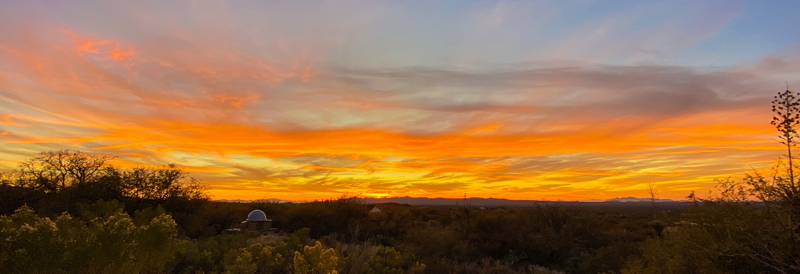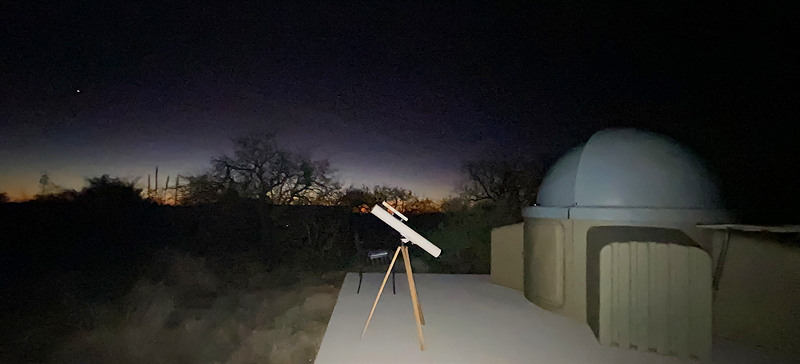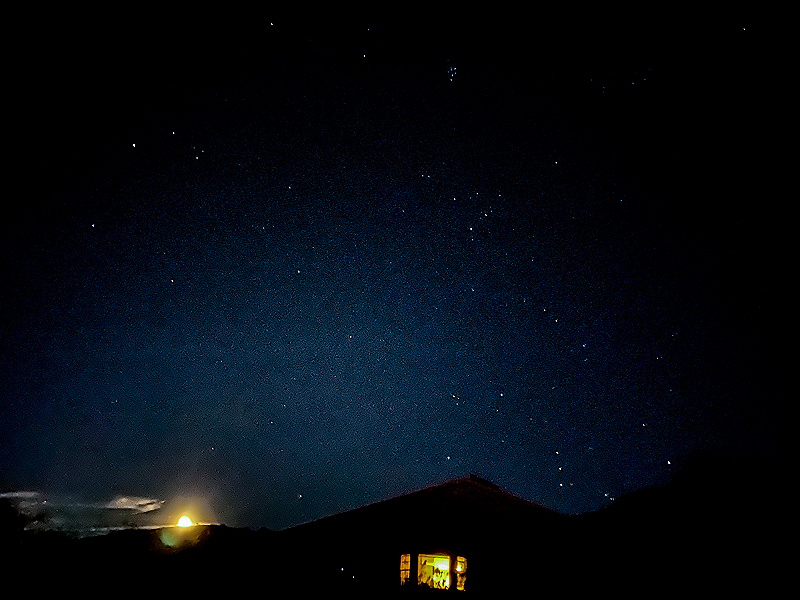Edmund Scientific 3" Newtonian observing,
iPhone Sky & Moon
Posted: 14 December 2019
Thursday, 12 December 2019, dawned clear but clouds began arriving mid-morning. Had a pretty awesome sunset that evening (iPhone 11 Pro Max Ultra Wide Angle lens).

Click or tap on image for larger version
The sky was clear on Friday, 13 December.
|
Open: Friday, 13 December 2019, 1804 MST Temperature: 59°F |
Session: 1413 Conditions: Clear, breezy |
Equipment:
3" f/10 Newtonian Reflector
0.965" 3/4" eyepiece
0.965" 1/2" eyepiece
0.965" 1/4" eyepiece
Camera:
iPhone 11 Pro Max
While waiting for power to be restored to the observatory I have been using some of my older telescopes when the sky conditions have allowed. This night I set up my Edmund Scientific 3" Newtonian Reflector telescope on the observatory patio.
Venus is at the left in the iPhone 11 Pro Max Ultra Wide Angle lens photo below (cropped)

This iPhone 11 Pro Max taken with Night Mode and the 2X telephoto lens shows the planets Venus (left) and Saturn (right) in the southwestern sky.

I used the 3" telescope to view Venus, 40X and 60X. The slight gibbous phase was visible. I then viewed Saturn, 40X and 60X. The view at 60X reminded me of my first view of Saturn through this 3" telescope on Easter morning in 1962.
Next, I viewed M45 (the Pleiades) and the Double Cluster (open star clusters), 40X. Both were nice views.
1839 MST: saw a possible Geminid meteor moving southward in the west sky near the constellations of Lyra and Aquila. It was fairly bright and fast.
1845 MST: viewed M57 (Ring Nebula), 60X. As I was viewing the Ring Nebula this night I remembered doing a hunt for M57 in 1962 and the thrill of seeing it for the first time back then.
The eastern sky was brightening from the soon to rise waning gibbous Moon. As the sky began brightening I was seeing more clouds.
Using the 3" telescope I viewed the star Aldebaran and other stars in the Hyades star cluster (in Taurus), 40X.
While waiting for the Moon to appear over the hill to the East I did some watching for Geminid meteors. Never saw any meteors but I did see lots of Earth-orbiting satellites.
1940 MST: the Moon began rising over the hill. This iPhone 11 Pro Max (Night Mode, 1X lens) shows the Moon rising at the left and Orion rising at the right. Auriga and Taurus are above the middle with the Pleiades at the top.

This handheld photo of the Moon was taken with the iPhone 11 Pro Max and 2X telephoto lens using the iOS app NightCap Camera (ISO 1600, 1/310sec). The inset shows a magnified view of the Moon.

1948 MST: with the Moon now visible I did some lunar observing with the 3" telescope, 40X. The view was very nice.
I took this handheld afocal 40X photo of the Moon with NightCap Camera (ISO 32, 1/700sec, 1X lens).

I did some more lunar observing, 40X, 60X, and 120X. Although the Moon was still low in the sky the view at 120X was pretty good.
Took this handheld iPhone afocal 120X photo with NightCap Camera (ISO 800, 1/600sec, 1X lens).

|
Close: Friday, 13 December 2019, 2015 MST Temperature: 52°F |
Session Length: 2h 11m Conditions: Mostly clear |
The 3" Newtonian was my first telescope. It was a Christmas present from my mother in December 1961. Here I am with the telescope by our house in southern Indiana on Easter morning 1962. I was able to recreate the 1961 photo when I visited my hometown in August 2016.


This was a fun session that brought back many pleasant memories of using this 3" telescope as a teenager so many years ago.
By the way, if you have photos of your Edmund Scientific telescopes I would like to include them on my Edmund Scientific Telescopes Memorial Page. Thanks.
Comments are welcome using Email. Twitter users can use the button below to tweet this report to their followers. Thanks.
Cassiopeia Observatory Home Page
Copyright ©2019 Michael L. Weasner / mweasner@me.com
URL = http://www.weasner.com/co/Reports/2019/12/14/index.html
